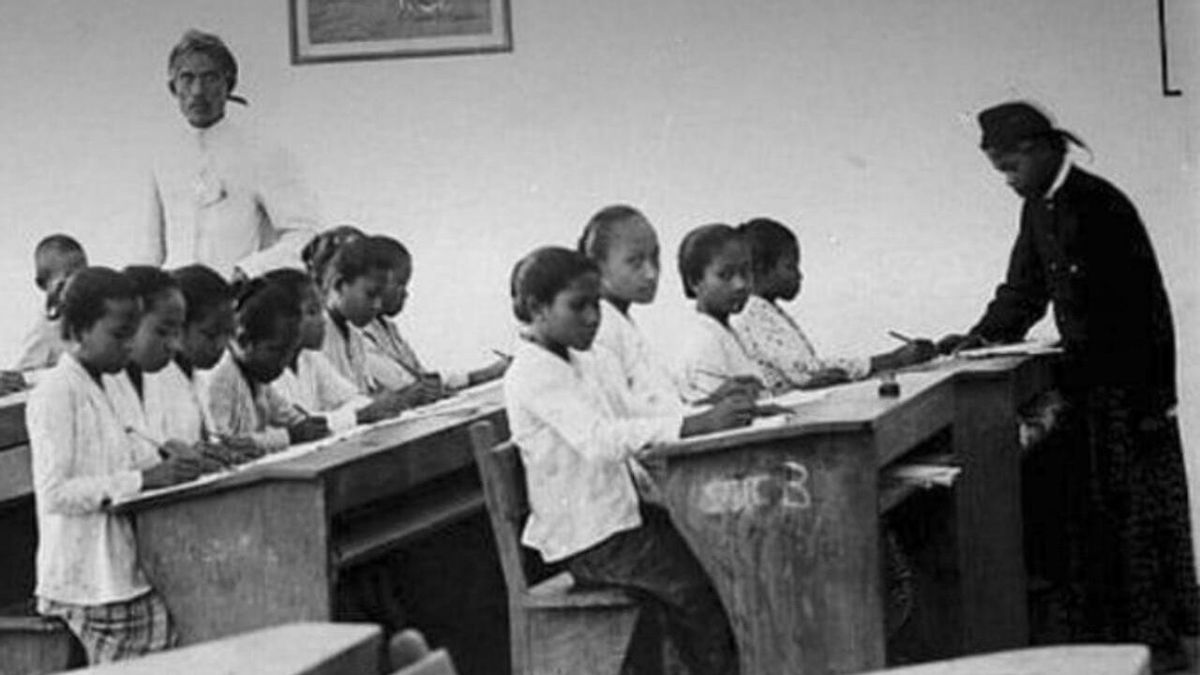JAKARTA - In the early days of independence, Indonesian people lived in a variety of cultures that grew as a national identity. In dress, for example. Kebaya is an important part of that era.
At that time, as we have told in "Clothing Without Social Class is called Kebaya", kebaya was used by every woman, without exception. It is common for officials to wear kebaya in their daily life.
If you trace its roots, kebaya was born from Javanese culture which then spread throughout the archipelago, both Maluku, Sumatra, Bali, to Sulawesi. Makassar State University anthropologist Dimas Aryo Sumilih explained that basically there are two identity characteristics at the root of using the kebaya.

First, kebaya was introduced in a limited scope, namely the Javanese tradition in the cultural environment of Yogyakarta and Surakarta. Second, kebaya which was introduced widely in various areas outside Java.
Take the example of Kebaya which was introduced only in the scope of Yogyakarta and Surakarta. The kebaya is known to have a grip on Javanese cultural arts. The standard is firm, clear, and there is an element of differentiation between the Yogya and Surakarta styles.
"Until now, this standard has been strictly maintained. Because the shape, pattern, decorative motifs and attributes have a deep philosophical meaning related to their ancestral tradition, namely Mataram. The use of this kebaya is not limited to aristocrats, but can extend to all circles. Social class differentiation appears in the patterns and decorations as well as the completeness of the attributes, "Dimas told VOI some time ago.
Meanwhile, kebaya outside the Java area is characterized by many modifications. From this modification, various types of kebaya emerged. Among other things, the Malay kebaya, Encim kebaya, Kartinian kebaya, Balinese kebaya and so on, complete with the attributes and characteristics of their respective regions.
However, the journey of the kebaya as the national dress of women was actually forgotten for a while. In the past, to be precise in the 1920s, there were regulations prohibiting the use of kebaya in public spaces for European or Indo-Dutch women.
This made the kebaya prestige, which had been known long before the Dutch colonized Indonesia, to fade. At that time, the Company invited citizens of the number one country in the Dutch East Indies (Indonesia) to return to their old habits, namely wearing colonial-style clothing among the public.
Famous through educational institutionsEven so, the kebaya has remained a mandatory garment for native women since the 19th century. At that time, kebaya was introduced through educational institutions. Yogyakarta was the beginning. Some of those who played a role were the King of Yogyakarta at that time, Sultan Hamengkubuwono VII (1839-1921). He founded modern schools called Sultanaats School.
In addition, when Ki Hajar Dewantara and the Tuesday Kliwon association established a college called the Nationaal Onderwijs Instituut Taman Siswa or the Taman Siswa National College Institute in 1922, he made the kebaya the mandatory clothing for female students. The identity of the kebaya as a national culture has also strengthened.
In accordance with the two main principles of Taman Siswa, namely democracy and leadership, kebaya is always maintained. Quoted from Ki Hajar Dewantara's writing entitled Associatie between East and West in Waskita - a magazine published by Taman Siswa - published in 1929, the Prince of Java invited all students not to swallow the European lifestyle.
"If we want a national lifestyle, we have to choose Western ways of life that are genuinely beneficial to us. It is at that moment that we have released ourselves from blind love. And we can choose calmly and with clear thoughts and feelings only then will there be association and evolution, ”wrote Ki Hajar Dewantara.

Ki Hajar Dewantara has long embraced a strong stance on national identity through seven reasons for establishing Taman Siswa. In the first point, Ki Hajar Dewantara's desire to use education and teaching as a means of nurturing the seeds passed down from previous generations is stated so that the nation can grow, both physically and spiritually.
"Just as the individual must develop his soul and body, so the nation must try to develop its culture and society. The means to achieve this goal must be based on national customs. In this way the nation will develop quickly and smoothly in accordance with the nature of nature, "said Kenji Tsuchiya in the book Democracy and Leadership: The Awakening of the Taman Siswa Movement (1987).
After Taman Siswa, then other educational institutions, such as HIS met den Quran, Schakelschool, Cursus voor Volks Onderwijs, Normaal school, and HIK - the forerunner of Muhammadiyah - were initiated by KH Ahmad Dahlan since 1911 to make kebaya a mandatory women's dress .
After Indonesia's independence, President Soekarno designated the kebaya as the national dress. As stated by Henk Schulte Nordholt in the book Outward Appearances: Trend, Identity, Interests (1998), Bung Karno has developed specific types of costumes to create a new Indonesian identity.
The essence of this identity is the conception of the values of Indonesian culture. "The national costumes developed by Sukarno and Suharto consisted of Western suits for men and kebaya cloths for women."
“On public stages, the body of a woman wearing a kebaya characterizes this nation as non-Western. The women's bodies represent the essence of the nation, a tradition that was alive and well at the end of the twentieth century, ”added Nordholt.
The English, Chinese, Japanese, Arabic, and French versions are automatically generated by the AI. So there may still be inaccuracies in translating, please always see Indonesian as our main language. (system supported by DigitalSiber.id)













